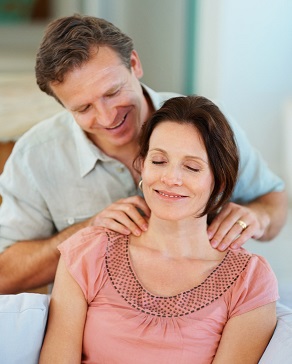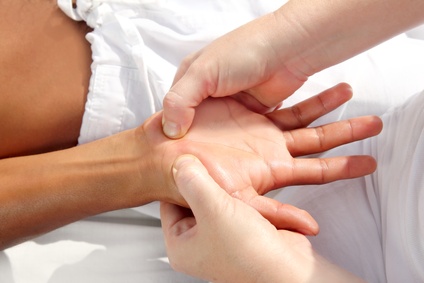
Touch is the first language we learn as infants. In the context of familial or consensual relationships, touch is vital to fostering a healthy and lasting bond between people. Studies have determined couples who are satisfied in their relationship touch each other with greater frequency. Furthermore, when we choose to initiate contact, we gain the same benefits as those in receipt of our touch. This mutual advantage of touch is precisely what instructor Carrie Brenith hopes to share with students joining Therapeutic Massage for Couples.
Brenith’s desire to explore the value of touch was inspired by her own experience as a recipient of massage therapy. “I started out receiving sports massage as a college athlete,” she recalls. “After having a displaced rib eased back into place by a massage therapist I was fascinated by the ability to manipulate the body and decided to go to massage school.”
Any seasoned massage therapist will be happy to tell you that giving a massage not only reduces the production of stress hormones in the recipient but encourages the release of oxytocin, a hormone that produces feelings of calm and comfort. “Touch can say so much,” says Brenith “We see it in our everyday lives; whether it be the respect in a firm handshake or the comfort of a friend’s hug. Touch is a universal language.”
It is important to note that though touch is vital to our quality of life, context is equally vital. Touch outside of a close relationship may push boundaries of what is socially acceptable and appropriate. Peter Andersen, author of Nonverbal Communication: Forms and Functions notes, "Touchy people are taking some risk that they might be perceived as being over-the-top or harassing." He further reminds us that physical contact out of appropriate context cannot only be creepy, but threatening. “Generally, from the shoulder down to the hand are the only acceptable areas for touch, at least between casual acquaintances.” Where touch is concerned? It is wise to ask for permission rather than forgiveness.
Brenith notes that Massage Tips for Partners, Friends and Family is not a massage training course, but an opportunity for the layperson to learn skills to foster greater intimacy and connection with people in their lives. “Many folks are already practicing home massage,” she says. “My goal is to share techniques that don’t require specialty equipment and reduce the wear and tear on the giver’s hands. Massage should be comfortable for both parties, and not result in sore hands!”
During each class session, Brenith will guide students through massage tips for particular areas of the body like the neck and shoulders, back, legs and feet. “I’ll demonstrate techniques while students follow along for the first section of class,” she says. “We’ll then move on to practice time with hands-on feedback and time for questions.”
As many couples in long-term relationships have discovered, touch does not always increase over time, but may actually diminish. In fact, studies of couples  participating in common acts of public affection demonstrated a regularity of touching in the outset of their courtship, but peaked at some point after marriage. “I want students to leave my class confident and comfortable,” says Brenith. “I want a half hour massage to be comfortable and effective for both parties, and I think the process techniques and hand positions I teach can do just that.”
participating in common acts of public affection demonstrated a regularity of touching in the outset of their courtship, but peaked at some point after marriage. “I want students to leave my class confident and comfortable,” says Brenith. “I want a half hour massage to be comfortable and effective for both parties, and I think the process techniques and hand positions I teach can do just that.”
Brenith looks forward to bringing people closer together with their class experience. “We were meant to feel comfortable in our bodies,” she says. “We’re meant to care for one another.”
Learn more about Therapeutic Massage for Couples.
Photo credit #2 David Watson cc 2.0
Photo credit #3 Fisioterapia Granada cc 2.0